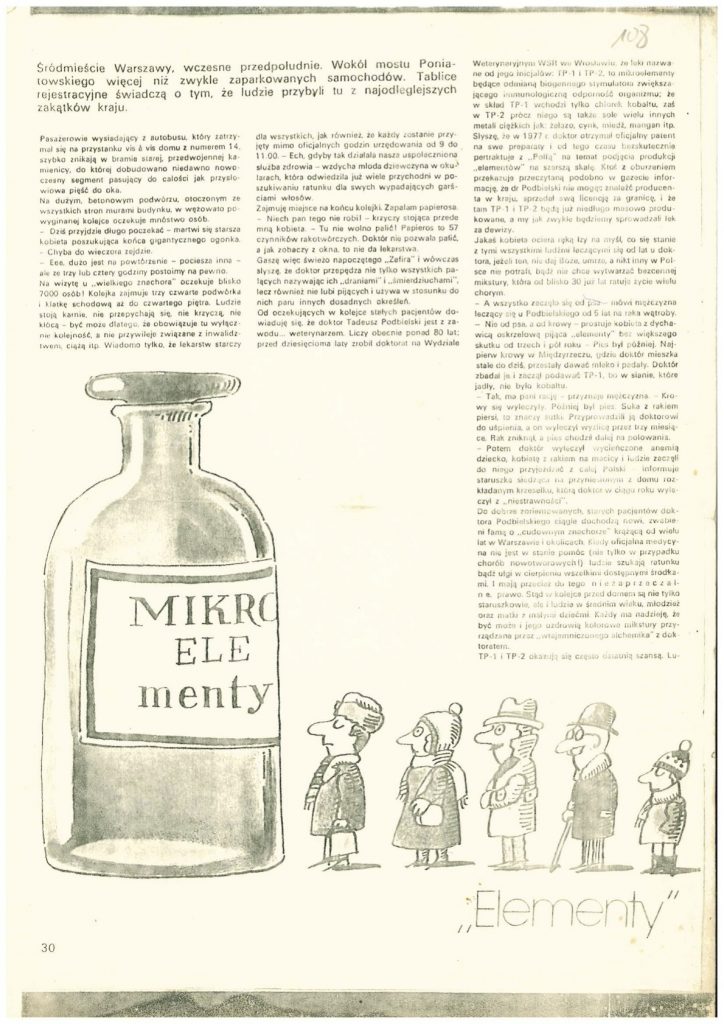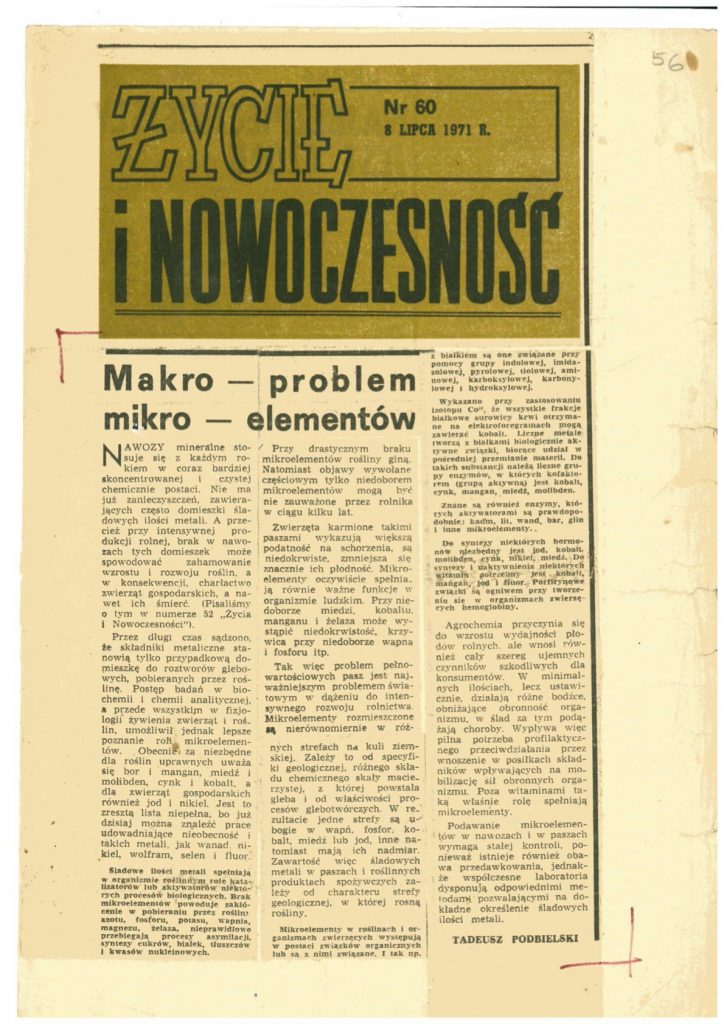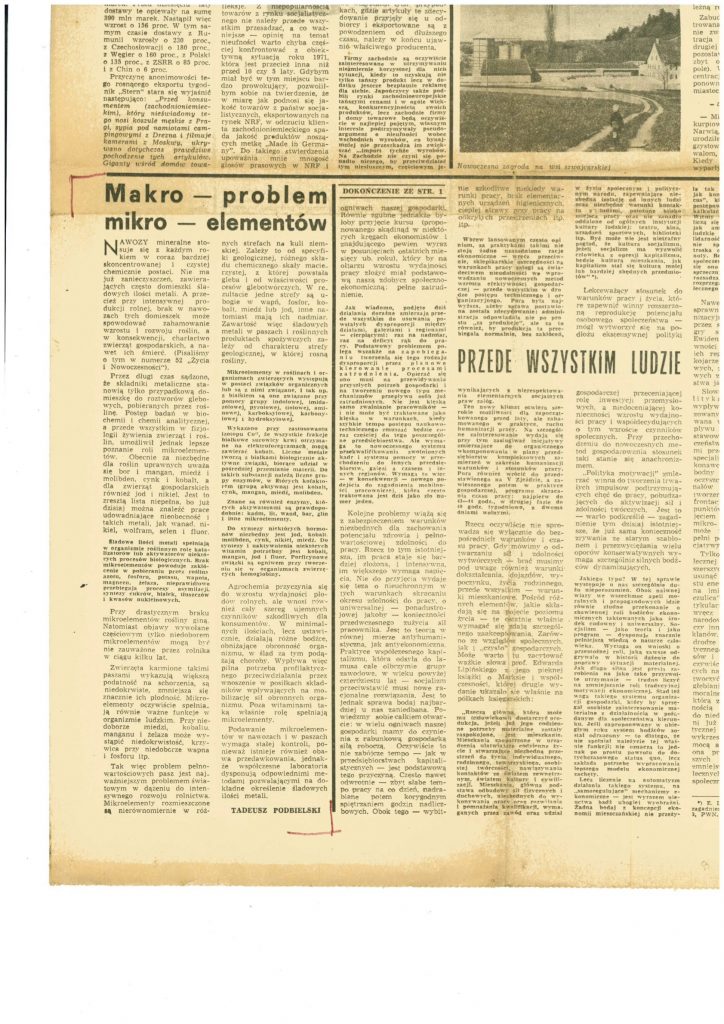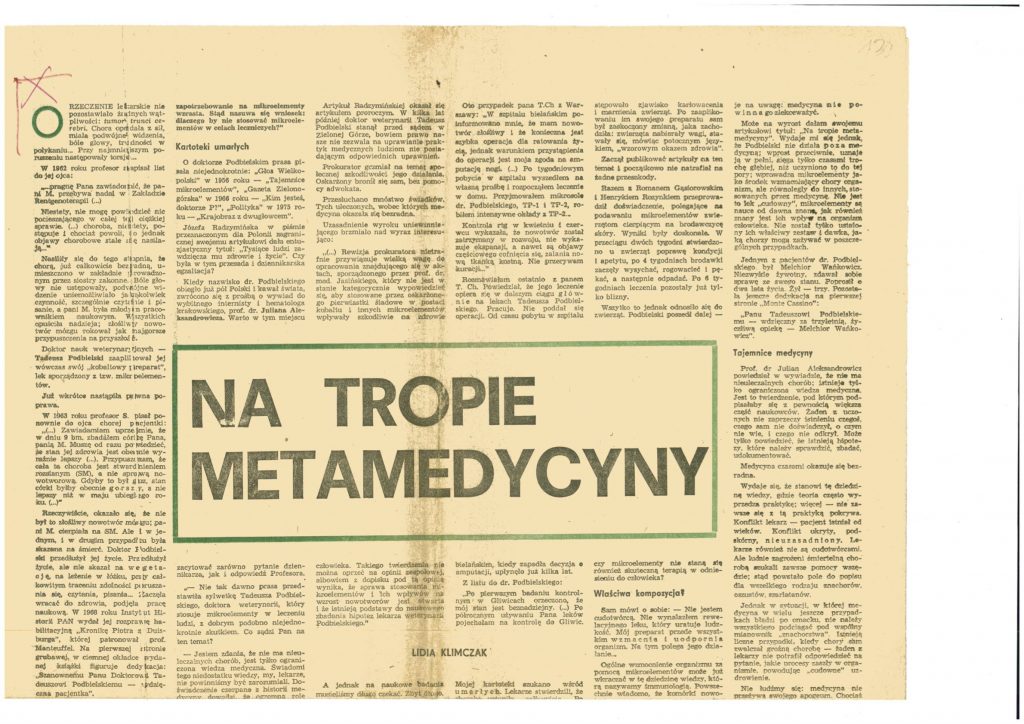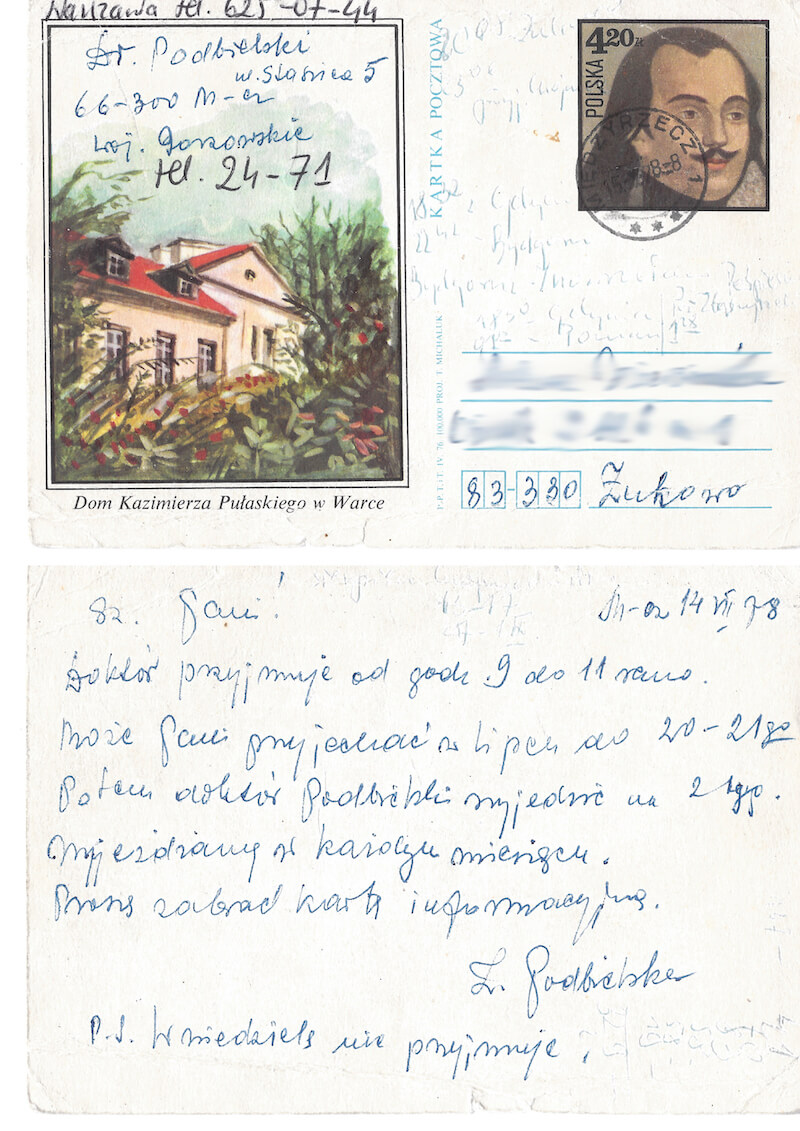The Common Word
Journal of the PAX Association
W-wa 11-12-13 March 1983.
"... I cried with happiness and - I knew that it was caused by the Lord's preparation...".
A passion for living for others
A Warsaw rental house in Powisle district, with a typical courtyard-well. In this courtyard winds a queue of people of all ages and genders. The queue laboriously climbs to the second floor of the tenement and here it joins with another one that reaches up to the top of the third or perhaps fourth floor. Both of these streams of people head for the apartment, on the door of which hangs a modest business card: Zofia and Tadeusz Podbielski.
Who is it? Tadeusz Podbielski?
- Dr. Z. K. doctor from outside Warsaw - Podbielski? Right away, for once, I heard something. No, I do not associate this name with anything.
- Dr. K. K. a doctor from Warsaw. - That's the charlatan what le or mallow extracts... What? You say it's not that one? But surely, surely mallow extracts.
- B. D, M.D., pharmacist - That name makes me think of something. I already know - micronutrients?
HUNDREDS of people who stand patiently in line know exactly what they came here for. They want to get two not big bottles with a mysterious inscription "TP-1" and "TP 2" Inside is a pink-colored liquid is the preparation TP 1, and with a brown-green color this color has TP 2. Is this a miracle drug, an elixir of life?
Ladies and gentlemen, imagine- a royal dinner, but without salt - a good one will not be - Dr. Podbielski's voice is strong and lively. What I am giving you is micro-salt. Similar to our table salt, this is the salt for the royal dinner. The idea is to improve the treatment...
The chat begins, for the next group of interested parties. In a small room an incredible squeeze, all the seats and standing places are occupied.
"Please listen urgently," repeats Dr. Podbielski because I do not have the opportunity to talk to each of you..."
Dr. Podbielski patiently explains how to use TP 1, in what amount and in what way. His language is colorful and juicy.
"...What does TP 1 do? Improves appetite where there is none. It regulates digestion and bowel movements. And this enemy needs to be swept out of our body every day. Through the blood, it improves oxidation. Lack of oxygen - it and in the stove do not want to burn, legs like cotton wool, lungs function badly. Oxygen, like a sword, beats germs.
However, if someone smokes cigarettes - there health will not be, there is no. There I do not give medicine, because why should we. In cigarettes we have only 57 carcinogens, enough?"
Dr. Podbielski's voice is rising to a shout. Acrimonious is the anti-smoking activist. He gives examples of nicotine poisoning "cultured house - I hear the story - masters, doctors, but chaps rotten, scrolled brains. Attention - it promises to be fertile - but for cancers, for heart attacks. Hard to talk, because hardly anyone understands. How many in the offices of these smokers. Is it a culture? To us it would be necessary to invite Khomeini to do some order.
Let's enter the hospital. And that's where it gets smoky too, the doctors, the nurses. Faces even nice, but from the mouth yawns those 57 carcinogens. Remember smokers, from the first cigarette you lay the foundation for cancer."
I LOOK discreetly at the assembled people. I see hands that put down the cigarette they already hold, seriousness is painted on their faces. No one is laughing, although the way they speak may seem ridiculous. If we had such activists, I think to myself, the tobacco monopoly would go with the bags in no time. Dr. Podbielski is suggestive, believes wholeheartedly in what he says, and will make others believe in his words.
The chat has been going on for several minutes. We are back to TP 1 and TP 2. There are various ways to apply the preparations - drinking, poultices, rinses, inhalations, lubrication. But the use of microsols, or micronutrients, is only half of Dr. Podbielski's prescription. The other half is diet, according to which one should avoid fried and smoked things ("tastier, but shorter you will ingest these delicacies"), enrich the daily menu with vitamins ("as much vitamin C as possible; but not in -pills, but in nature"), drink herbs ("a protective coat, a shield for our body"). All in all, the prescription serves to strengthen the defensive forces, for it is necessary to "capture this beast, chain it ! da funnel let it bark lightly already".
Rich and vivid is the language of Dr. Podbielski, He conjures before the listeners images as if from a battlefield, in which he goes for the health and well-being of the patient. The main weapons are TP 1 and TP 2 preparations. But at the same time none of the doctor's patients are allowed to escape from official medicine, abandon prescribed treatment, forgo surgery. Dok tor Podbielski does not claim the right to treat the drops are to be that pinch of salt to the royal dinner.
Environmental chain
MICROELEMENTS, trace amounts of elements such as iron, copper, zinc, magnesium, cobalt. As it turns out, these elements are very necessary for a number of processes in living organisms. Today, the value of micronutrients is no secret to anyone. They enrich, they are an ingredient in vitamin preparations, they are an ingredient in all kinds of nutrients, such as the fashionable BIOVITAL or BUERLECITINA (to buy in Pewex), VITARAL, FALVIT and to buy in pharmacies. So what's so great about Dr. Podbielski's drops? What sets them apart from hundreds of similar preparations? Before I try to answer these questions, let's see how it all started
And it started a good few decades ago, when no one had yet dreamed of micronutrients. District veterinarian from Miedzyrzecz Dr. Tadeusz Podbielski associated the poor health of cattle with poor soil, which lacked... essential mineral salts, micronutrients.
It was 1948, and it was difficult to get everything, but not for Dr. Podbielski, who "howled" the necessary elements, even cobalt. Added to the feed in the form of a salt solution (which Mr. and Mrs. Podbielski first tried on themselves at the physiological level), they had a positive effect. The health of the animals improved before their eyes - the cows began to eat willingly, gained weight and began to give as much milk as decent cows should give.
The FIRST experiments also brought the first eyeful of publicity. After cows, it was the turn of pigs, followed by dogs. Finally, it was the turn of humans. Dr. Podbielski was already convinced that micronutrients "were the way to go," that he was taking the right path. Those first patients were a "run-down" rural family. Because where the animals were undernourished, there the people were also unwell.
- Dr. Podbielski, says Associate Professor Stanislaw Grabiec, head of the Biochemistry and Biophysics Laboratory of the Department of Parasitology of the Polish Academy of Sciences, approached the matter in a scientific way, as systematic ecological methods require. Soil - soil products animals - people: He observed, perceived and drew conclusions.
Few people have such a gift - of constantly thinking, of constantly ' asking themselves the question "why?", of constantly searching for the answer to this question.
And maybe that's why Doc. Grabiec considers Dr. Podbielski as one of those who are like milestones in science.... And he has known Dr. Podbielski for more than a dozen years, has worked with him and knows what he is talking about.
The first official presentation also took place at that time. The doctor, in a paper entitled. "Beneficial Results of Micronutrients in Animals and Humans," he naturally presented the results of his work, those results of which he was certain. It was also an attempt to enter official medicine.
This entrance Dr. Podbielski is still paving his way today. But when asked about recognition from official medicine, he waves his hand dismissively - it's difficult in our country to get "scientific support." There has been no ba ding of the drug in oncology clinics, although such studies were announced. Dr. Podbielski has in his archives letters from the Institute of Oncology in Gliwice, from the Department of Endocrinology of the Medical University of Lodz, and rich correspondence with the Institute of Oncology in Warsaw. The content of the letters is similar to the one he received from the Institute of Oncology, in which Prof. K. notifies him that "at the moment, due to the preoccupation with work on the government program 'fighting cancer', we do not have the possibility to conduct research in tissue culture and on animals." The letter is accompanied by a memo from three doctors at the institute, who write: "After reviewing the materials provided on the effects of micronutrients on oncological diseases, we conclude that nothing can be said on the basis of these data about the effects of these substances on the animal and human body." And that "clinical observation of patients, in whom cobalt salts were used at one time, did not confirm their therapeutic study in tumors," and that "the preparations can be of interest to laboratories performing animal ba ditions, tissue cultures and other pharmacological studies."
That was in 1976, Prof. K. in an interview in February 1983, does not change his mind. "May write tells me that-no therapeutic effect found," he says. Of Dr. Podbielski, he has a good opinion.
Thus, neither yes nor no. The sentences are balanced, but not just because courtesy demands it. It is difficult to definitively deny the documentation presented by Dr. Podbielski, it is difficult to unequivocally negate the testimonies of people who, after treatment with "TP 1″ and "TP 2″, feel great, perfectly tolerate such dangerous therapeutic methods as radiation, it is difficult to resist thousands of letters expressing gratitude. Official medicine does not want to admit "TP 1″ and "TP 2″. Prof. Maria D., a neuropathologist, said: "I know that my patients who take Podbielski micronutrients feel great. But I officially can't without research after know anything concrete."
But it's not true that the studies aren't there. Are there? They are carried out by Dr. Podbielski himself, an indefatigable spirit, a man who, at 71, could afford to submit and defend (not at all "painted") his doctoral thesis: ,;The effect of trace amounts of cobalt chloride on oxidoreductive processes in parasites on the example of the liver fluke". I learn about a study that measured the survival time of mice exposed to micro-phthalates. Those watered with cobalt chloride lived the longest (14 sec), mice in the control group without cobalt died after 3, 4 seconds. Other studies conducted by the Department of Human Physiology at the Institute of Biological Sciences at the AWF (also on mice) confirm these results. And here "mice with cobalt" lived longer in tightly closed cages than mice that were not given cobalt. So what lies in Dr. Podbielski's drops?
Biogenic stimulator
Associate Professor Stanislaw Grabiec said:
- I met Dr. Podbielski 15 years ago at a meeting of the M. Copernicus Polish Natural History Society. He re ferred his work with enthusiasm. I must admit that I didn't believe it very much. However, I got a sample and began to give it by analytical methods. And it turned out that the doctor's preparation works wonderfully as a biocatalyst, like an enzyme.
- Combustion in a living cell is controlled, - doc. Gra biec passionately explains the processes concerning the secret of life, - and enzymes are responsible for this. But enzymes are proteins, and behind tem large particles. Moreover - particles that are easily poisoned, destroyed, inactivated. Micronutrients work in a similar way, but the difference is that as small chemical particles, they penetrate more easily, and are not destroyed. This is an important detail from the point of view of physiology. If their action is similar to that of an enzyme, that is; it relies on o law of oxidoreductive processes.
- Oxidoreductive processes - oxidation and reduction, One more concept to decipher. These processes determine the life of the cell, the continuous metabolism. In the so-called metabolic mill there is constantly adenosine triphosphoric acid - ATP. However, in order for this acid to be formed, oxidation and reduction processes are needed. "TP 1" intensifies these processes, using the preparation accelerates the energy-generating processes. So? So, "TP 1″ is not a drug. It is a valuable biostimulator. And just the discovery that it is a biostimulator - was a big surprise for the docent.
DOC. GRABIEC demonstrates to me the action of micronutrients using a photon emission analyzer. The screen of the apparatus shows numbers - this is the number of photons emitted during combustion The numbers increase in order to, then settle at a certain, constant level. The so-called "plateau" is formed, the processes are just maintained at a certain, constant level, the combustion is very economical and efficient. As it happens in nature, This is another value of micronutrients Podbielskie go - physiological action.
The second value - the form in which these micronutrients are given, the most physiological form, in diluted solution. Thanks to this, micronutrients almost immediately penetrate into the blood, the moment of critical concentration (not safe potential difference at the phase boundary), which we have to deal with when micronutrients are administered in solid form, such as in lozenges, is bypassed.
The third value - a set of micronutrients. "TP 1" is first of all cobalt chloride which in Podbielski's is active always, Given allegations of optimal concentration. The concentrations are so small that even the addition of cobalt will not spoil anything. "TP 2" is much richer, it contains more elements, There is iron - necessary for electro n transport, copper - needed for proteins, zinc and magnesium - important for biosynthesis processes. The selection of micronutrients is such that their effects do not cancel each other out.
And "TP 2″ acts on a number of processes in the living organism.
- In my numerous conversations I have encountered the statement that micronutrients are, after all, nothing new, that there is no point in taking Podbielski drops if you get the same thing by swallowing vitamin mines. So I ask the docent what makes Pod bielski's micronutrients different from the ones we have on the market.
- It is like this: as happens with great inventions after particular elements are well known, but the whole presents a completely new quality. To get a set of values of "TP 2" you need to take at least five different vitamin preparations. And the equivalent of ,,TP 1″ does not exist at all.
I am still learning that biostimulants are especially needed for decaying diseases. This is where the success of "TP 1" and "TP 2" in cancer comes from. That they are especially valuable for old people as so-called "excitons" a under carrying life energy. That allegations like "micronutrients work for everything" are unfounded, because they are not medicines and are not about curing but about boosting immunity.
He expresses enthusiasm about Dr. Podbielski, with whom he has worked and collaborated for so many years. He appreciates his analytical outlook, his insightful and critical in premise research programs creative passion. " I have witnessed many conversations - he is a very thoughtful and wise man. In any work we did, his participation was always greater. Even the so-called black work he did willingly and with youthful energy. Podbielski is treated by doctors with a bit of irony - well, not bad, but maybe he took it from the Germans? Podbielski came to everything by his own work. He is a beautiful example of a free scientist who has his own idea and pursues it independently.
When on, the market?
The ONLY manufacturer of "TP 1" and "TP 2" so far is Dr. Podbielski. A few years ago he received a patent for his preparations. But this does not at all mean that he guards the secrets of the workshop jealously. He has been submitting applications for development and dissemination since the mid-1960s. The results are not forthcoming.
What are the chances of producing "TP 1" and "TP 2" on a wider scale? In the pharmacy department, I learn that in order for "something" to happen to a drug, first of all, an attestation is needed about the so-called expediency of production. Such an attestation is issued by the Medicines Commission under the Ministry of Health, the process is long and must be expertly documented. I also learn that Dr. Podbielski has little chance. of such expediency being granted, because after all... micronutrients are known and used. Unless..., the effect of "his" micronutrients, would be absolutely unique.
At the Institute of Medicines they tell me that first there must be a positive opinion of the Medicines Commission, and only then does the institute to become a drug for testing. Well, and the most important thing - first there must be a manufacturer, a factory that produces the drug. It is the factory that receives the approval, never a private person. And research without the pharmaceutical industry cannot be undertaken, because it is the industry that evaluates a number of parameters.
The procedure for introducing a new drug, moreover, is in general an incredibly arduous and lengthy procedure. It requires experiments on animals and then clinical trials on humans. These are comparative studies, during which the proposed drug is pitted against the best one used so far. It is a machine so complicated that a private person has no chance here. So first, second and third you need a manufacturer.
Dr. Tadeusz Podbielski is reaching his eighties. "TP 1" and "TP 2" officially do not exist. Although hundreds of people crowd into the Warsaw apartment, although thousands come to Miedzyrzecz Although in the home archives of Mr. and Mrs. Podbielski one can find dozens of thank you dedications, including from passed people of science, who do not mind that "TP 1" and "TP 2" brought Dr. Podbielski to the court bench three times.
Podbielski's micronutrients are known in the wits of Polish hospitals. Sick people drink them, and doctors don't mind. Their fame has long since crossed the borders of the country. Podbielski was interested in the USSR, where he was invited several times, in America, West Germany. And who knows if the proverb will not be valid again; that no one is a prophet in his own country.
But for now... For now, Dr. Podbielski and his wife Sophia are preparing, with their own hands, their specifics. Although it's getting harder and harder for them to get raw materials, it's getting harder and harder to get bottles. But can the trust of those who wait be reposed? Those who see a shadow of hope in magic drops? So they don't fail, and later receive letters like this one from Sophia N:
- "I learned that there is no sign of malignant cancer. There are minimal lesions that can be cured. I cried with happiness, and I knew that the Lord's preparation had caused this..."
MARIA ZERA
